Analysis of Lean Management Implementation in Construction Industry
VerifiedAdded on 2023/06/10
|46
|13582
|329
Report
AI Summary
This report delves into the implementation of lean management within the UK construction industry. It begins with an introduction highlighting the sector's significance and the potential for growth through technological advancements and export activities. The report examines the principles of lean construction, focusing on waste elimination and the management of sustainability. It outlines the aims and objectives, which include reviewing existing literature, exploring the dimensions of lean management, identifying and evaluating implementation barriers, examining industry perceptions, and analyzing the impact of lean tools and techniques. The methodology involves a review of literature, data collection through primary and secondary sources, and both qualitative and quantitative analysis. The report also addresses project risks, scope and limitations, and confidentiality issues. The literature review defines lean management, its principles, and its origins in manufacturing. It emphasizes the importance of value creation, waste reduction, and continuous improvement. The report concludes by underscoring the benefits of lean construction but also acknowledges the challenges in sustaining its implementation. The report provides a comprehensive overview of lean management in construction.
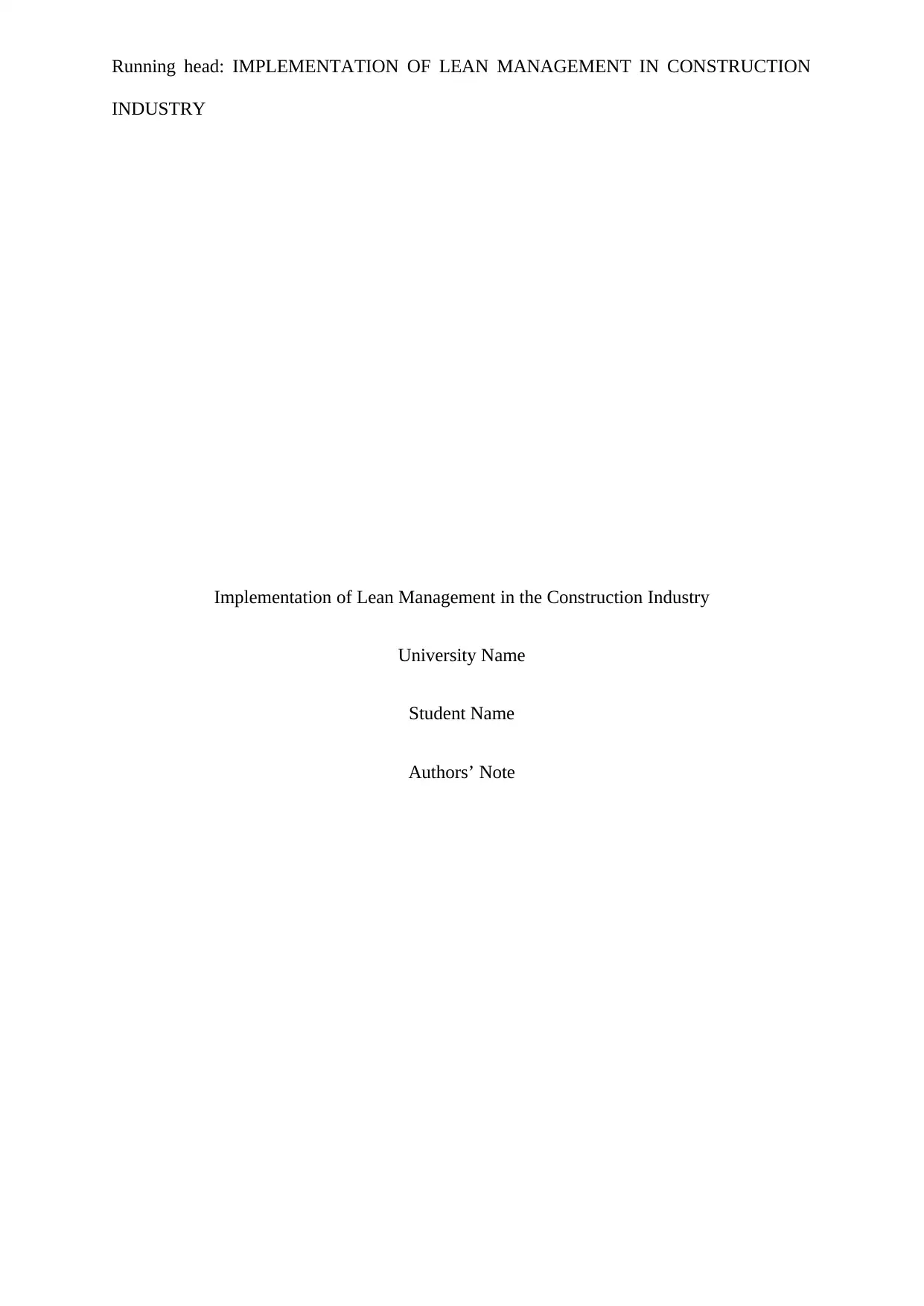
Running head: IMPLEMENTATION OF LEAN MANAGEMENT IN CONSTRUCTION
INDUSTRY
Implementation of Lean Management in the Construction Industry
University Name
Student Name
Authors’ Note
INDUSTRY
Implementation of Lean Management in the Construction Industry
University Name
Student Name
Authors’ Note
Paraphrase This Document
Need a fresh take? Get an instant paraphrase of this document with our AI Paraphraser
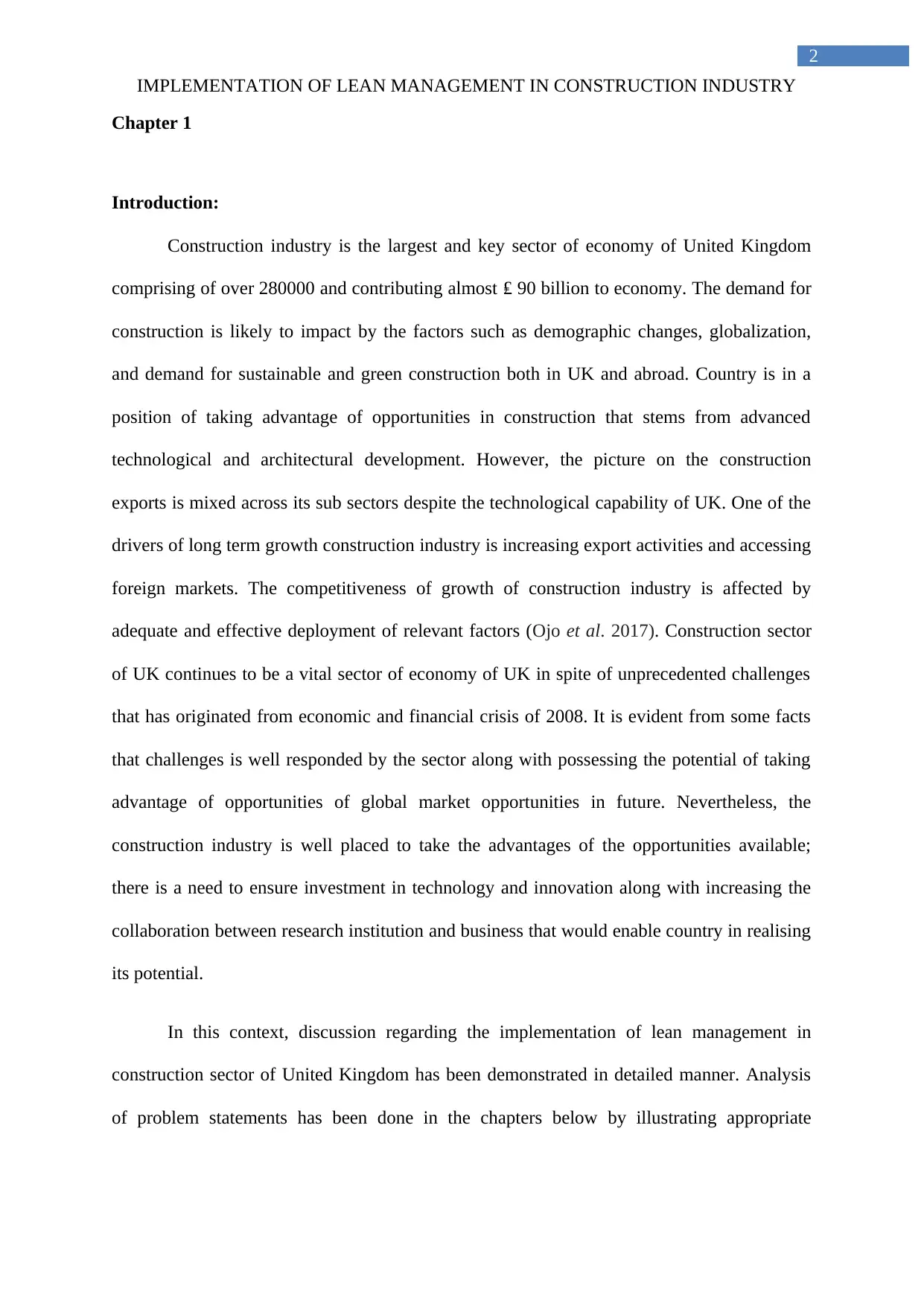
2
IMPLEMENTATION OF LEAN MANAGEMENT IN CONSTRUCTION INDUSTRY
Chapter 1
Introduction:
Construction industry is the largest and key sector of economy of United Kingdom
comprising of over 280000 and contributing almost ₤ 90 billion to economy. The demand for
construction is likely to impact by the factors such as demographic changes, globalization,
and demand for sustainable and green construction both in UK and abroad. Country is in a
position of taking advantage of opportunities in construction that stems from advanced
technological and architectural development. However, the picture on the construction
exports is mixed across its sub sectors despite the technological capability of UK. One of the
drivers of long term growth construction industry is increasing export activities and accessing
foreign markets. The competitiveness of growth of construction industry is affected by
adequate and effective deployment of relevant factors (Ojo et al. 2017). Construction sector
of UK continues to be a vital sector of economy of UK in spite of unprecedented challenges
that has originated from economic and financial crisis of 2008. It is evident from some facts
that challenges is well responded by the sector along with possessing the potential of taking
advantage of opportunities of global market opportunities in future. Nevertheless, the
construction industry is well placed to take the advantages of the opportunities available;
there is a need to ensure investment in technology and innovation along with increasing the
collaboration between research institution and business that would enable country in realising
its potential.
In this context, discussion regarding the implementation of lean management in
construction sector of United Kingdom has been demonstrated in detailed manner. Analysis
of problem statements has been done in the chapters below by illustrating appropriate
IMPLEMENTATION OF LEAN MANAGEMENT IN CONSTRUCTION INDUSTRY
Chapter 1
Introduction:
Construction industry is the largest and key sector of economy of United Kingdom
comprising of over 280000 and contributing almost ₤ 90 billion to economy. The demand for
construction is likely to impact by the factors such as demographic changes, globalization,
and demand for sustainable and green construction both in UK and abroad. Country is in a
position of taking advantage of opportunities in construction that stems from advanced
technological and architectural development. However, the picture on the construction
exports is mixed across its sub sectors despite the technological capability of UK. One of the
drivers of long term growth construction industry is increasing export activities and accessing
foreign markets. The competitiveness of growth of construction industry is affected by
adequate and effective deployment of relevant factors (Ojo et al. 2017). Construction sector
of UK continues to be a vital sector of economy of UK in spite of unprecedented challenges
that has originated from economic and financial crisis of 2008. It is evident from some facts
that challenges is well responded by the sector along with possessing the potential of taking
advantage of opportunities of global market opportunities in future. Nevertheless, the
construction industry is well placed to take the advantages of the opportunities available;
there is a need to ensure investment in technology and innovation along with increasing the
collaboration between research institution and business that would enable country in realising
its potential.
In this context, discussion regarding the implementation of lean management in
construction sector of United Kingdom has been demonstrated in detailed manner. Analysis
of problem statements has been done in the chapters below by illustrating appropriate
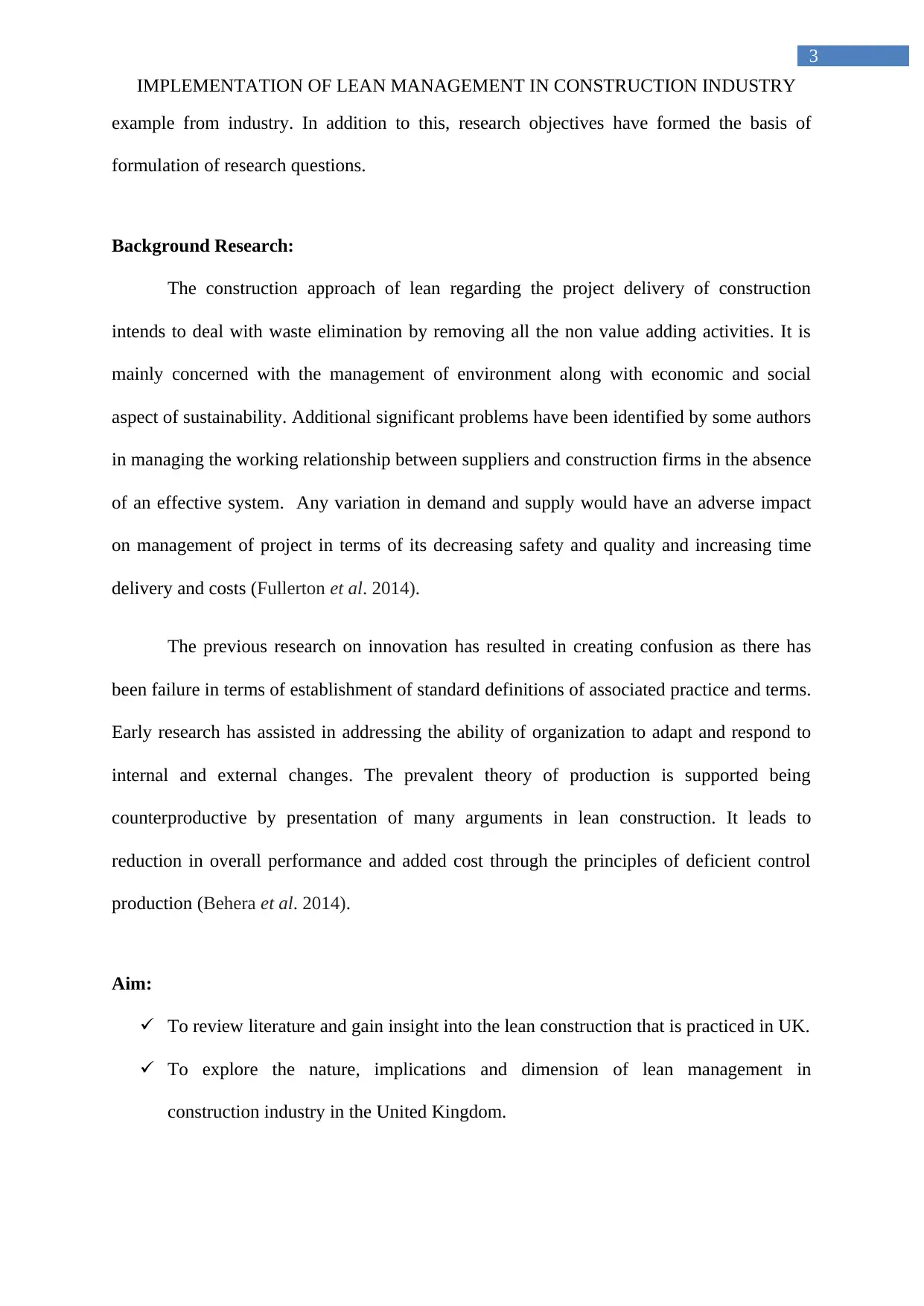
3
IMPLEMENTATION OF LEAN MANAGEMENT IN CONSTRUCTION INDUSTRY
example from industry. In addition to this, research objectives have formed the basis of
formulation of research questions.
Background Research:
The construction approach of lean regarding the project delivery of construction
intends to deal with waste elimination by removing all the non value adding activities. It is
mainly concerned with the management of environment along with economic and social
aspect of sustainability. Additional significant problems have been identified by some authors
in managing the working relationship between suppliers and construction firms in the absence
of an effective system. Any variation in demand and supply would have an adverse impact
on management of project in terms of its decreasing safety and quality and increasing time
delivery and costs (Fullerton et al. 2014).
The previous research on innovation has resulted in creating confusion as there has
been failure in terms of establishment of standard definitions of associated practice and terms.
Early research has assisted in addressing the ability of organization to adapt and respond to
internal and external changes. The prevalent theory of production is supported being
counterproductive by presentation of many arguments in lean construction. It leads to
reduction in overall performance and added cost through the principles of deficient control
production (Behera et al. 2014).
Aim:
To review literature and gain insight into the lean construction that is practiced in UK.
To explore the nature, implications and dimension of lean management in
construction industry in the United Kingdom.
IMPLEMENTATION OF LEAN MANAGEMENT IN CONSTRUCTION INDUSTRY
example from industry. In addition to this, research objectives have formed the basis of
formulation of research questions.
Background Research:
The construction approach of lean regarding the project delivery of construction
intends to deal with waste elimination by removing all the non value adding activities. It is
mainly concerned with the management of environment along with economic and social
aspect of sustainability. Additional significant problems have been identified by some authors
in managing the working relationship between suppliers and construction firms in the absence
of an effective system. Any variation in demand and supply would have an adverse impact
on management of project in terms of its decreasing safety and quality and increasing time
delivery and costs (Fullerton et al. 2014).
The previous research on innovation has resulted in creating confusion as there has
been failure in terms of establishment of standard definitions of associated practice and terms.
Early research has assisted in addressing the ability of organization to adapt and respond to
internal and external changes. The prevalent theory of production is supported being
counterproductive by presentation of many arguments in lean construction. It leads to
reduction in overall performance and added cost through the principles of deficient control
production (Behera et al. 2014).
Aim:
To review literature and gain insight into the lean construction that is practiced in UK.
To explore the nature, implications and dimension of lean management in
construction industry in the United Kingdom.
⊘ This is a preview!⊘
Do you want full access?
Subscribe today to unlock all pages.

Trusted by 1+ million students worldwide
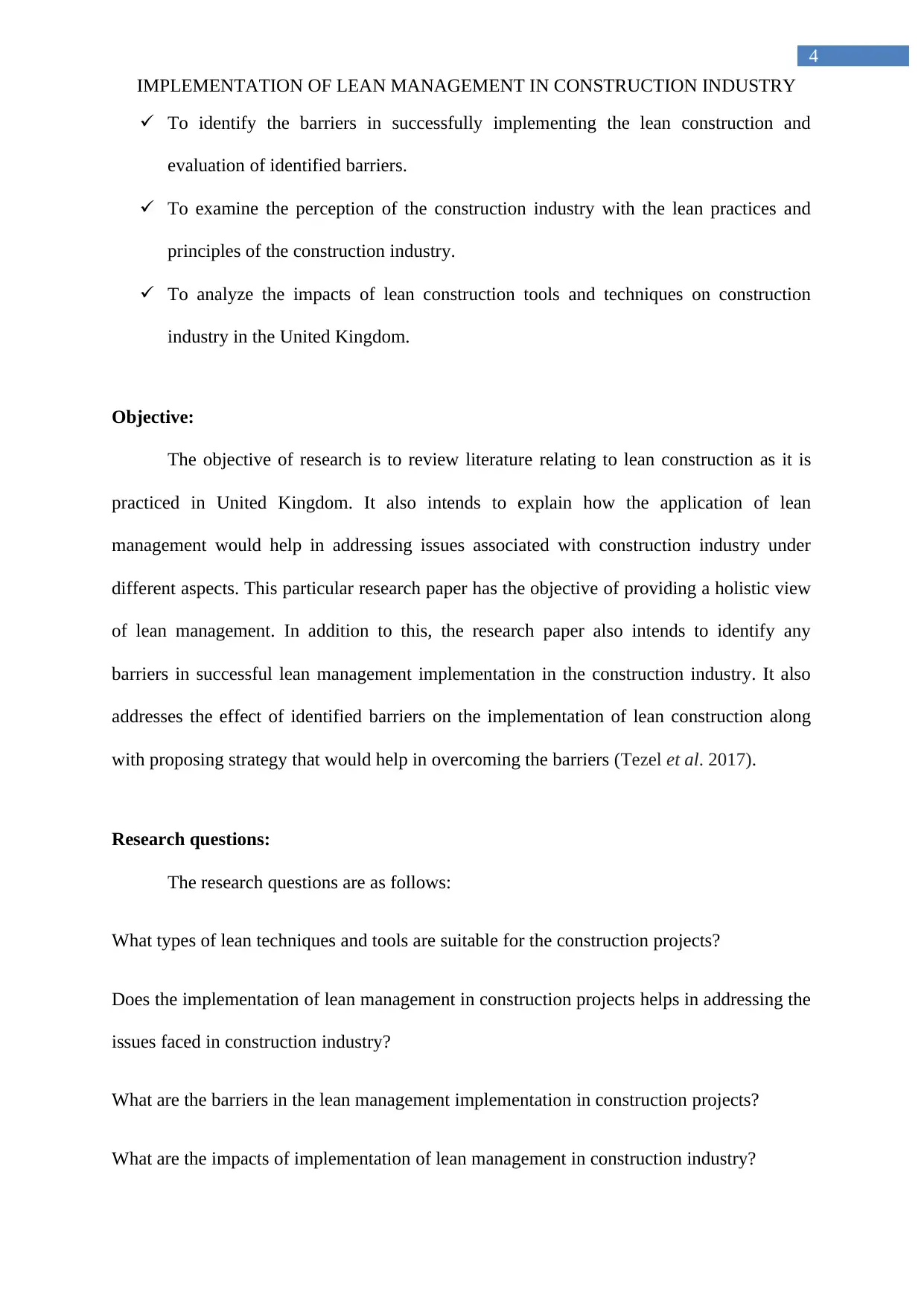
4
IMPLEMENTATION OF LEAN MANAGEMENT IN CONSTRUCTION INDUSTRY
To identify the barriers in successfully implementing the lean construction and
evaluation of identified barriers.
To examine the perception of the construction industry with the lean practices and
principles of the construction industry.
To analyze the impacts of lean construction tools and techniques on construction
industry in the United Kingdom.
Objective:
The objective of research is to review literature relating to lean construction as it is
practiced in United Kingdom. It also intends to explain how the application of lean
management would help in addressing issues associated with construction industry under
different aspects. This particular research paper has the objective of providing a holistic view
of lean management. In addition to this, the research paper also intends to identify any
barriers in successful lean management implementation in the construction industry. It also
addresses the effect of identified barriers on the implementation of lean construction along
with proposing strategy that would help in overcoming the barriers (Tezel et al. 2017).
Research questions:
The research questions are as follows:
What types of lean techniques and tools are suitable for the construction projects?
Does the implementation of lean management in construction projects helps in addressing the
issues faced in construction industry?
What are the barriers in the lean management implementation in construction projects?
What are the impacts of implementation of lean management in construction industry?
IMPLEMENTATION OF LEAN MANAGEMENT IN CONSTRUCTION INDUSTRY
To identify the barriers in successfully implementing the lean construction and
evaluation of identified barriers.
To examine the perception of the construction industry with the lean practices and
principles of the construction industry.
To analyze the impacts of lean construction tools and techniques on construction
industry in the United Kingdom.
Objective:
The objective of research is to review literature relating to lean construction as it is
practiced in United Kingdom. It also intends to explain how the application of lean
management would help in addressing issues associated with construction industry under
different aspects. This particular research paper has the objective of providing a holistic view
of lean management. In addition to this, the research paper also intends to identify any
barriers in successful lean management implementation in the construction industry. It also
addresses the effect of identified barriers on the implementation of lean construction along
with proposing strategy that would help in overcoming the barriers (Tezel et al. 2017).
Research questions:
The research questions are as follows:
What types of lean techniques and tools are suitable for the construction projects?
Does the implementation of lean management in construction projects helps in addressing the
issues faced in construction industry?
What are the barriers in the lean management implementation in construction projects?
What are the impacts of implementation of lean management in construction industry?
Paraphrase This Document
Need a fresh take? Get an instant paraphrase of this document with our AI Paraphraser
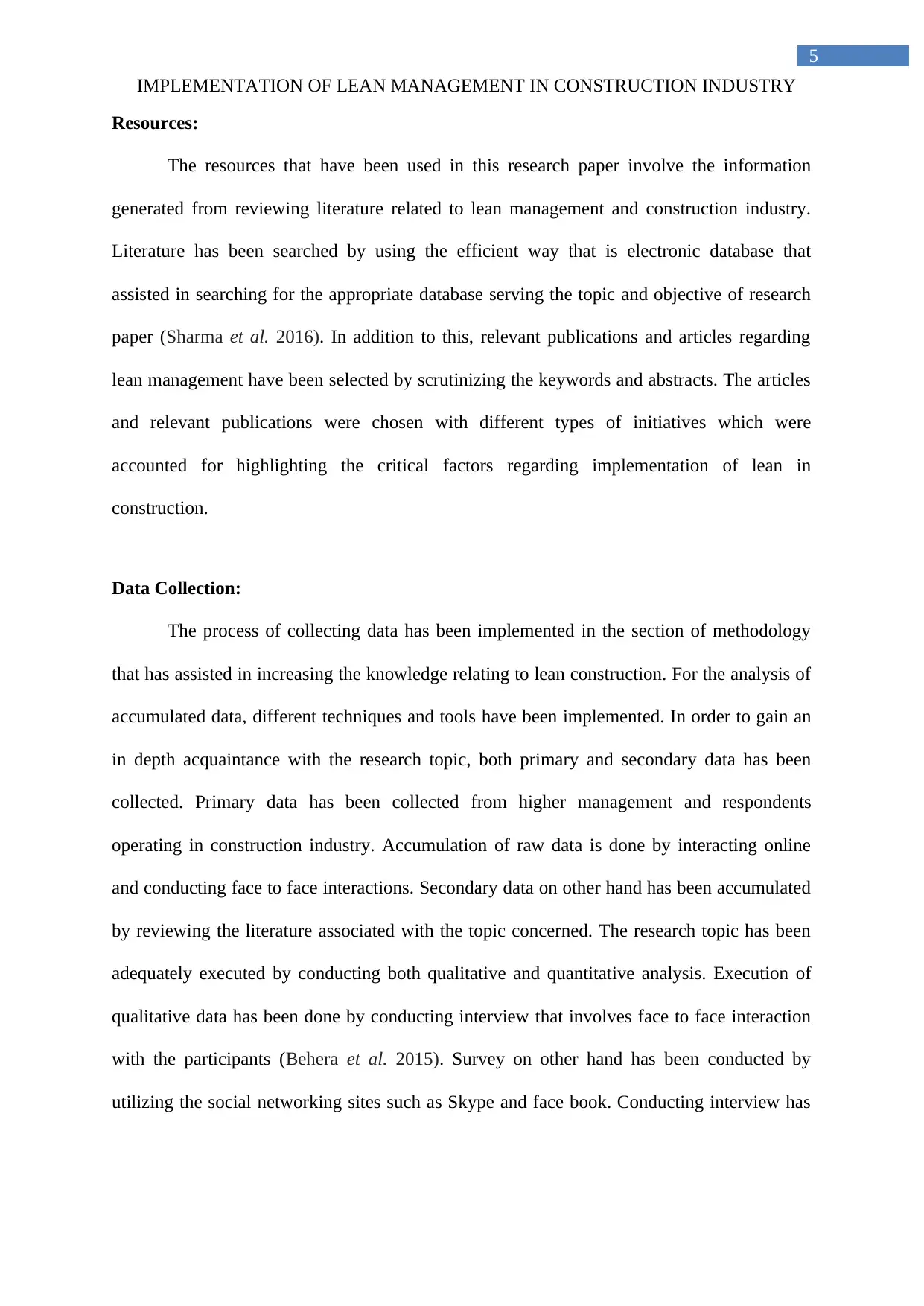
5
IMPLEMENTATION OF LEAN MANAGEMENT IN CONSTRUCTION INDUSTRY
Resources:
The resources that have been used in this research paper involve the information
generated from reviewing literature related to lean management and construction industry.
Literature has been searched by using the efficient way that is electronic database that
assisted in searching for the appropriate database serving the topic and objective of research
paper (Sharma et al. 2016). In addition to this, relevant publications and articles regarding
lean management have been selected by scrutinizing the keywords and abstracts. The articles
and relevant publications were chosen with different types of initiatives which were
accounted for highlighting the critical factors regarding implementation of lean in
construction.
Data Collection:
The process of collecting data has been implemented in the section of methodology
that has assisted in increasing the knowledge relating to lean construction. For the analysis of
accumulated data, different techniques and tools have been implemented. In order to gain an
in depth acquaintance with the research topic, both primary and secondary data has been
collected. Primary data has been collected from higher management and respondents
operating in construction industry. Accumulation of raw data is done by interacting online
and conducting face to face interactions. Secondary data on other hand has been accumulated
by reviewing the literature associated with the topic concerned. The research topic has been
adequately executed by conducting both qualitative and quantitative analysis. Execution of
qualitative data has been done by conducting interview that involves face to face interaction
with the participants (Behera et al. 2015). Survey on other hand has been conducted by
utilizing the social networking sites such as Skype and face book. Conducting interview has
IMPLEMENTATION OF LEAN MANAGEMENT IN CONSTRUCTION INDUSTRY
Resources:
The resources that have been used in this research paper involve the information
generated from reviewing literature related to lean management and construction industry.
Literature has been searched by using the efficient way that is electronic database that
assisted in searching for the appropriate database serving the topic and objective of research
paper (Sharma et al. 2016). In addition to this, relevant publications and articles regarding
lean management have been selected by scrutinizing the keywords and abstracts. The articles
and relevant publications were chosen with different types of initiatives which were
accounted for highlighting the critical factors regarding implementation of lean in
construction.
Data Collection:
The process of collecting data has been implemented in the section of methodology
that has assisted in increasing the knowledge relating to lean construction. For the analysis of
accumulated data, different techniques and tools have been implemented. In order to gain an
in depth acquaintance with the research topic, both primary and secondary data has been
collected. Primary data has been collected from higher management and respondents
operating in construction industry. Accumulation of raw data is done by interacting online
and conducting face to face interactions. Secondary data on other hand has been accumulated
by reviewing the literature associated with the topic concerned. The research topic has been
adequately executed by conducting both qualitative and quantitative analysis. Execution of
qualitative data has been done by conducting interview that involves face to face interaction
with the participants (Behera et al. 2015). Survey on other hand has been conducted by
utilizing the social networking sites such as Skype and face book. Conducting interview has
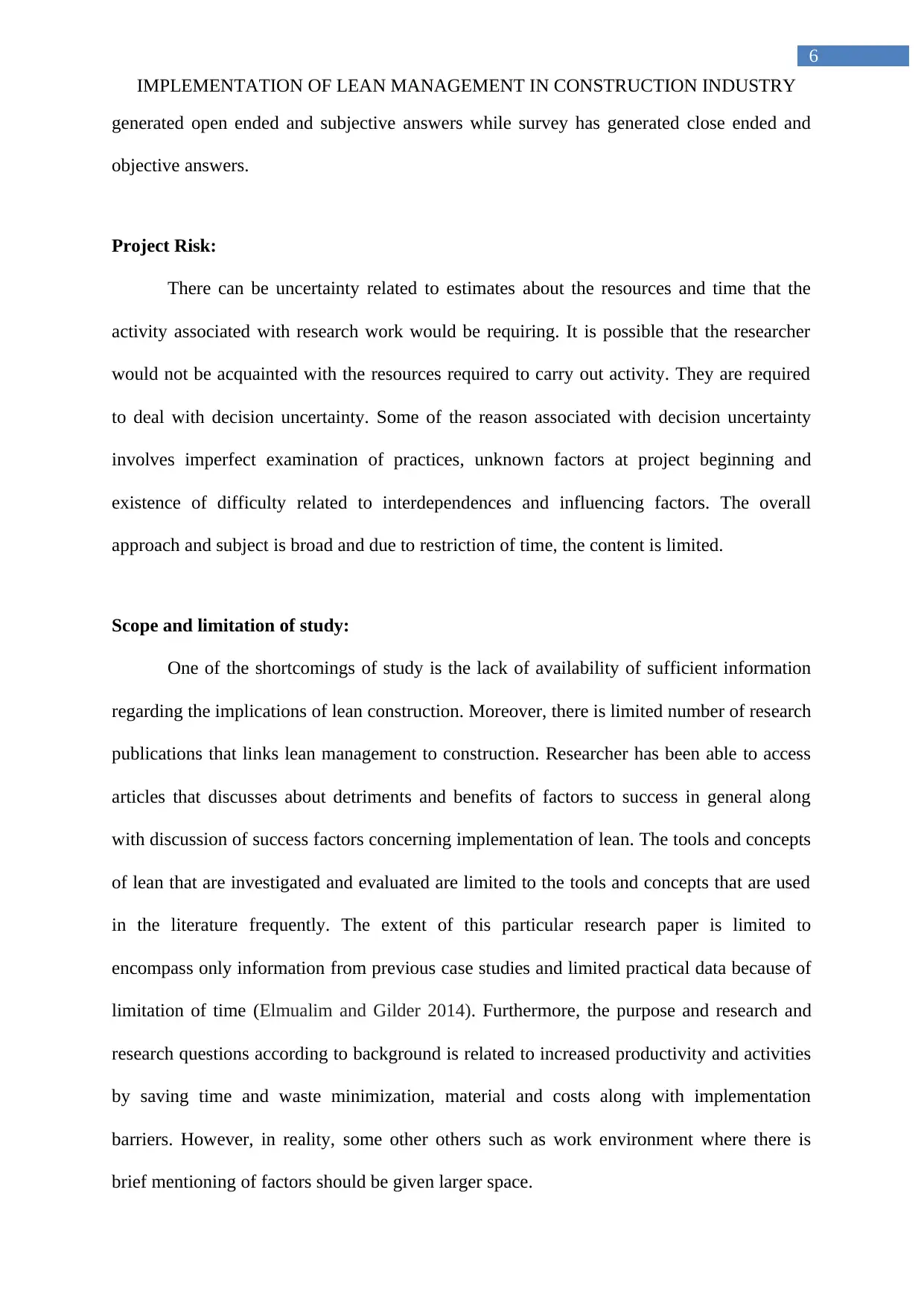
6
IMPLEMENTATION OF LEAN MANAGEMENT IN CONSTRUCTION INDUSTRY
generated open ended and subjective answers while survey has generated close ended and
objective answers.
Project Risk:
There can be uncertainty related to estimates about the resources and time that the
activity associated with research work would be requiring. It is possible that the researcher
would not be acquainted with the resources required to carry out activity. They are required
to deal with decision uncertainty. Some of the reason associated with decision uncertainty
involves imperfect examination of practices, unknown factors at project beginning and
existence of difficulty related to interdependences and influencing factors. The overall
approach and subject is broad and due to restriction of time, the content is limited.
Scope and limitation of study:
One of the shortcomings of study is the lack of availability of sufficient information
regarding the implications of lean construction. Moreover, there is limited number of research
publications that links lean management to construction. Researcher has been able to access
articles that discusses about detriments and benefits of factors to success in general along
with discussion of success factors concerning implementation of lean. The tools and concepts
of lean that are investigated and evaluated are limited to the tools and concepts that are used
in the literature frequently. The extent of this particular research paper is limited to
encompass only information from previous case studies and limited practical data because of
limitation of time (Elmualim and Gilder 2014). Furthermore, the purpose and research and
research questions according to background is related to increased productivity and activities
by saving time and waste minimization, material and costs along with implementation
barriers. However, in reality, some other others such as work environment where there is
brief mentioning of factors should be given larger space.
IMPLEMENTATION OF LEAN MANAGEMENT IN CONSTRUCTION INDUSTRY
generated open ended and subjective answers while survey has generated close ended and
objective answers.
Project Risk:
There can be uncertainty related to estimates about the resources and time that the
activity associated with research work would be requiring. It is possible that the researcher
would not be acquainted with the resources required to carry out activity. They are required
to deal with decision uncertainty. Some of the reason associated with decision uncertainty
involves imperfect examination of practices, unknown factors at project beginning and
existence of difficulty related to interdependences and influencing factors. The overall
approach and subject is broad and due to restriction of time, the content is limited.
Scope and limitation of study:
One of the shortcomings of study is the lack of availability of sufficient information
regarding the implications of lean construction. Moreover, there is limited number of research
publications that links lean management to construction. Researcher has been able to access
articles that discusses about detriments and benefits of factors to success in general along
with discussion of success factors concerning implementation of lean. The tools and concepts
of lean that are investigated and evaluated are limited to the tools and concepts that are used
in the literature frequently. The extent of this particular research paper is limited to
encompass only information from previous case studies and limited practical data because of
limitation of time (Elmualim and Gilder 2014). Furthermore, the purpose and research and
research questions according to background is related to increased productivity and activities
by saving time and waste minimization, material and costs along with implementation
barriers. However, in reality, some other others such as work environment where there is
brief mentioning of factors should be given larger space.
⊘ This is a preview!⊘
Do you want full access?
Subscribe today to unlock all pages.

Trusted by 1+ million students worldwide
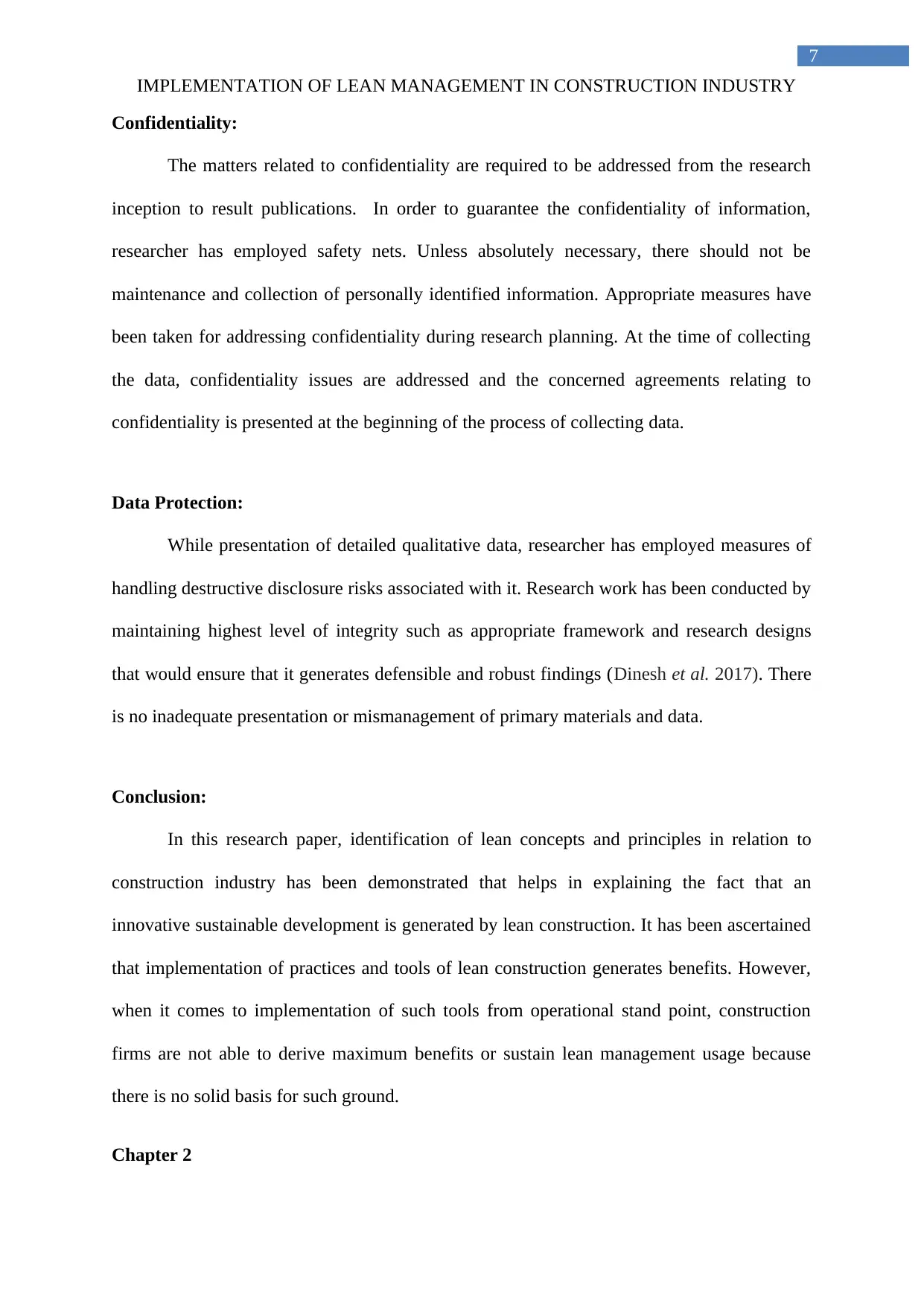
7
IMPLEMENTATION OF LEAN MANAGEMENT IN CONSTRUCTION INDUSTRY
Confidentiality:
The matters related to confidentiality are required to be addressed from the research
inception to result publications. In order to guarantee the confidentiality of information,
researcher has employed safety nets. Unless absolutely necessary, there should not be
maintenance and collection of personally identified information. Appropriate measures have
been taken for addressing confidentiality during research planning. At the time of collecting
the data, confidentiality issues are addressed and the concerned agreements relating to
confidentiality is presented at the beginning of the process of collecting data.
Data Protection:
While presentation of detailed qualitative data, researcher has employed measures of
handling destructive disclosure risks associated with it. Research work has been conducted by
maintaining highest level of integrity such as appropriate framework and research designs
that would ensure that it generates defensible and robust findings (Dinesh et al. 2017). There
is no inadequate presentation or mismanagement of primary materials and data.
Conclusion:
In this research paper, identification of lean concepts and principles in relation to
construction industry has been demonstrated that helps in explaining the fact that an
innovative sustainable development is generated by lean construction. It has been ascertained
that implementation of practices and tools of lean construction generates benefits. However,
when it comes to implementation of such tools from operational stand point, construction
firms are not able to derive maximum benefits or sustain lean management usage because
there is no solid basis for such ground.
Chapter 2
IMPLEMENTATION OF LEAN MANAGEMENT IN CONSTRUCTION INDUSTRY
Confidentiality:
The matters related to confidentiality are required to be addressed from the research
inception to result publications. In order to guarantee the confidentiality of information,
researcher has employed safety nets. Unless absolutely necessary, there should not be
maintenance and collection of personally identified information. Appropriate measures have
been taken for addressing confidentiality during research planning. At the time of collecting
the data, confidentiality issues are addressed and the concerned agreements relating to
confidentiality is presented at the beginning of the process of collecting data.
Data Protection:
While presentation of detailed qualitative data, researcher has employed measures of
handling destructive disclosure risks associated with it. Research work has been conducted by
maintaining highest level of integrity such as appropriate framework and research designs
that would ensure that it generates defensible and robust findings (Dinesh et al. 2017). There
is no inadequate presentation or mismanagement of primary materials and data.
Conclusion:
In this research paper, identification of lean concepts and principles in relation to
construction industry has been demonstrated that helps in explaining the fact that an
innovative sustainable development is generated by lean construction. It has been ascertained
that implementation of practices and tools of lean construction generates benefits. However,
when it comes to implementation of such tools from operational stand point, construction
firms are not able to derive maximum benefits or sustain lean management usage because
there is no solid basis for such ground.
Chapter 2
Paraphrase This Document
Need a fresh take? Get an instant paraphrase of this document with our AI Paraphraser
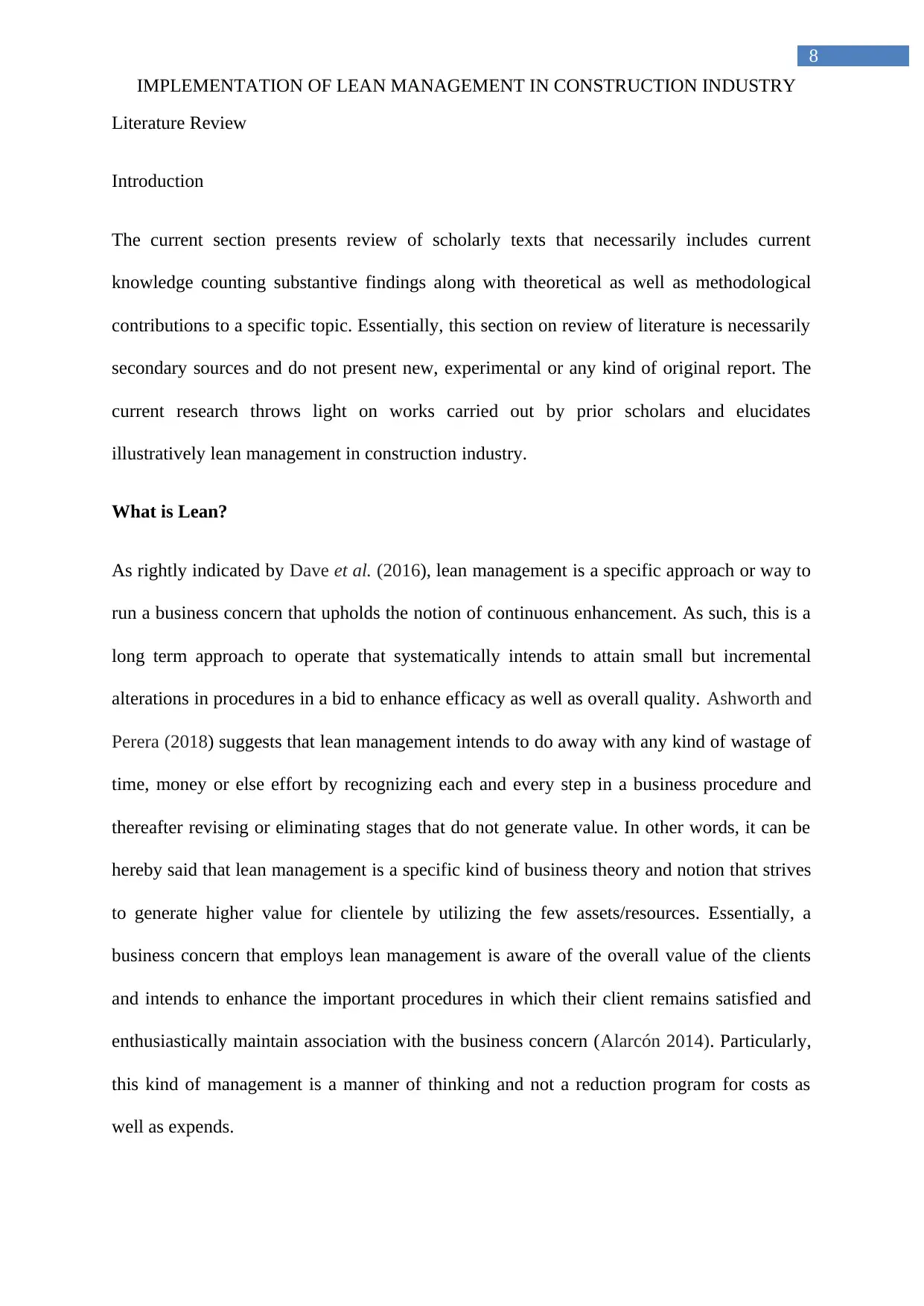
8
IMPLEMENTATION OF LEAN MANAGEMENT IN CONSTRUCTION INDUSTRY
Literature Review
Introduction
The current section presents review of scholarly texts that necessarily includes current
knowledge counting substantive findings along with theoretical as well as methodological
contributions to a specific topic. Essentially, this section on review of literature is necessarily
secondary sources and do not present new, experimental or any kind of original report. The
current research throws light on works carried out by prior scholars and elucidates
illustratively lean management in construction industry.
What is Lean?
As rightly indicated by Dave et al. (2016), lean management is a specific approach or way to
run a business concern that upholds the notion of continuous enhancement. As such, this is a
long term approach to operate that systematically intends to attain small but incremental
alterations in procedures in a bid to enhance efficacy as well as overall quality. Ashworth and
Perera (2018) suggests that lean management intends to do away with any kind of wastage of
time, money or else effort by recognizing each and every step in a business procedure and
thereafter revising or eliminating stages that do not generate value. In other words, it can be
hereby said that lean management is a specific kind of business theory and notion that strives
to generate higher value for clientele by utilizing the few assets/resources. Essentially, a
business concern that employs lean management is aware of the overall value of the clients
and intends to enhance the important procedures in which their client remains satisfied and
enthusiastically maintain association with the business concern (Alarcón 2014). Particularly,
this kind of management is a manner of thinking and not a reduction program for costs as
well as expends.
IMPLEMENTATION OF LEAN MANAGEMENT IN CONSTRUCTION INDUSTRY
Literature Review
Introduction
The current section presents review of scholarly texts that necessarily includes current
knowledge counting substantive findings along with theoretical as well as methodological
contributions to a specific topic. Essentially, this section on review of literature is necessarily
secondary sources and do not present new, experimental or any kind of original report. The
current research throws light on works carried out by prior scholars and elucidates
illustratively lean management in construction industry.
What is Lean?
As rightly indicated by Dave et al. (2016), lean management is a specific approach or way to
run a business concern that upholds the notion of continuous enhancement. As such, this is a
long term approach to operate that systematically intends to attain small but incremental
alterations in procedures in a bid to enhance efficacy as well as overall quality. Ashworth and
Perera (2018) suggests that lean management intends to do away with any kind of wastage of
time, money or else effort by recognizing each and every step in a business procedure and
thereafter revising or eliminating stages that do not generate value. In other words, it can be
hereby said that lean management is a specific kind of business theory and notion that strives
to generate higher value for clientele by utilizing the few assets/resources. Essentially, a
business concern that employs lean management is aware of the overall value of the clients
and intends to enhance the important procedures in which their client remains satisfied and
enthusiastically maintain association with the business concern (Alarcón 2014). Particularly,
this kind of management is a manner of thinking and not a reduction program for costs as
well as expends.
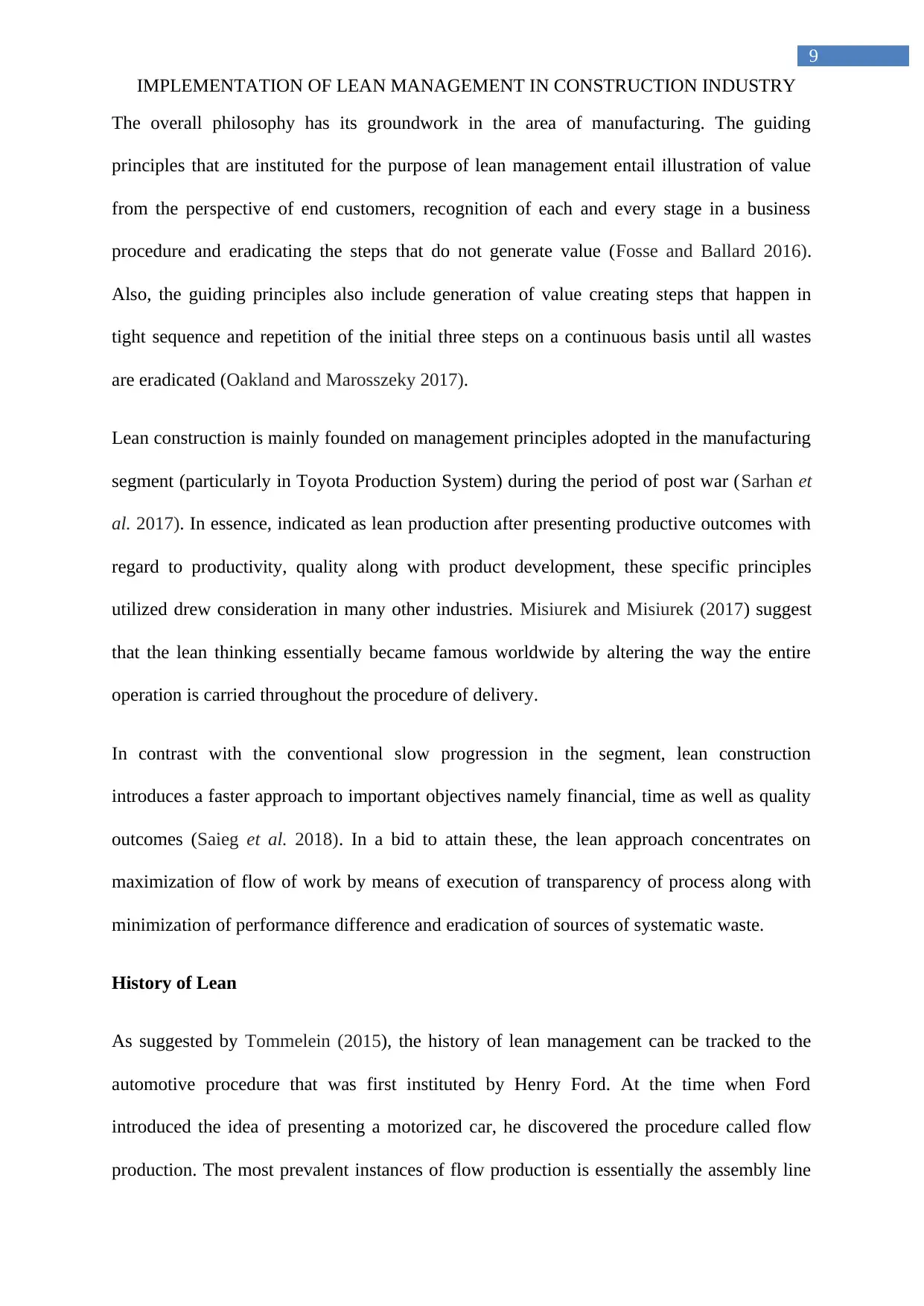
9
IMPLEMENTATION OF LEAN MANAGEMENT IN CONSTRUCTION INDUSTRY
The overall philosophy has its groundwork in the area of manufacturing. The guiding
principles that are instituted for the purpose of lean management entail illustration of value
from the perspective of end customers, recognition of each and every stage in a business
procedure and eradicating the steps that do not generate value (Fosse and Ballard 2016).
Also, the guiding principles also include generation of value creating steps that happen in
tight sequence and repetition of the initial three steps on a continuous basis until all wastes
are eradicated (Oakland and Marosszeky 2017).
Lean construction is mainly founded on management principles adopted in the manufacturing
segment (particularly in Toyota Production System) during the period of post war (Sarhan et
al. 2017). In essence, indicated as lean production after presenting productive outcomes with
regard to productivity, quality along with product development, these specific principles
utilized drew consideration in many other industries. Misiurek and Misiurek (2017) suggest
that the lean thinking essentially became famous worldwide by altering the way the entire
operation is carried throughout the procedure of delivery.
In contrast with the conventional slow progression in the segment, lean construction
introduces a faster approach to important objectives namely financial, time as well as quality
outcomes (Saieg et al. 2018). In a bid to attain these, the lean approach concentrates on
maximization of flow of work by means of execution of transparency of process along with
minimization of performance difference and eradication of sources of systematic waste.
History of Lean
As suggested by Tommelein (2015), the history of lean management can be tracked to the
automotive procedure that was first instituted by Henry Ford. At the time when Ford
introduced the idea of presenting a motorized car, he discovered the procedure called flow
production. The most prevalent instances of flow production is essentially the assembly line
IMPLEMENTATION OF LEAN MANAGEMENT IN CONSTRUCTION INDUSTRY
The overall philosophy has its groundwork in the area of manufacturing. The guiding
principles that are instituted for the purpose of lean management entail illustration of value
from the perspective of end customers, recognition of each and every stage in a business
procedure and eradicating the steps that do not generate value (Fosse and Ballard 2016).
Also, the guiding principles also include generation of value creating steps that happen in
tight sequence and repetition of the initial three steps on a continuous basis until all wastes
are eradicated (Oakland and Marosszeky 2017).
Lean construction is mainly founded on management principles adopted in the manufacturing
segment (particularly in Toyota Production System) during the period of post war (Sarhan et
al. 2017). In essence, indicated as lean production after presenting productive outcomes with
regard to productivity, quality along with product development, these specific principles
utilized drew consideration in many other industries. Misiurek and Misiurek (2017) suggest
that the lean thinking essentially became famous worldwide by altering the way the entire
operation is carried throughout the procedure of delivery.
In contrast with the conventional slow progression in the segment, lean construction
introduces a faster approach to important objectives namely financial, time as well as quality
outcomes (Saieg et al. 2018). In a bid to attain these, the lean approach concentrates on
maximization of flow of work by means of execution of transparency of process along with
minimization of performance difference and eradication of sources of systematic waste.
History of Lean
As suggested by Tommelein (2015), the history of lean management can be tracked to the
automotive procedure that was first instituted by Henry Ford. At the time when Ford
introduced the idea of presenting a motorized car, he discovered the procedure called flow
production. The most prevalent instances of flow production is essentially the assembly line
⊘ This is a preview!⊘
Do you want full access?
Subscribe today to unlock all pages.

Trusted by 1+ million students worldwide
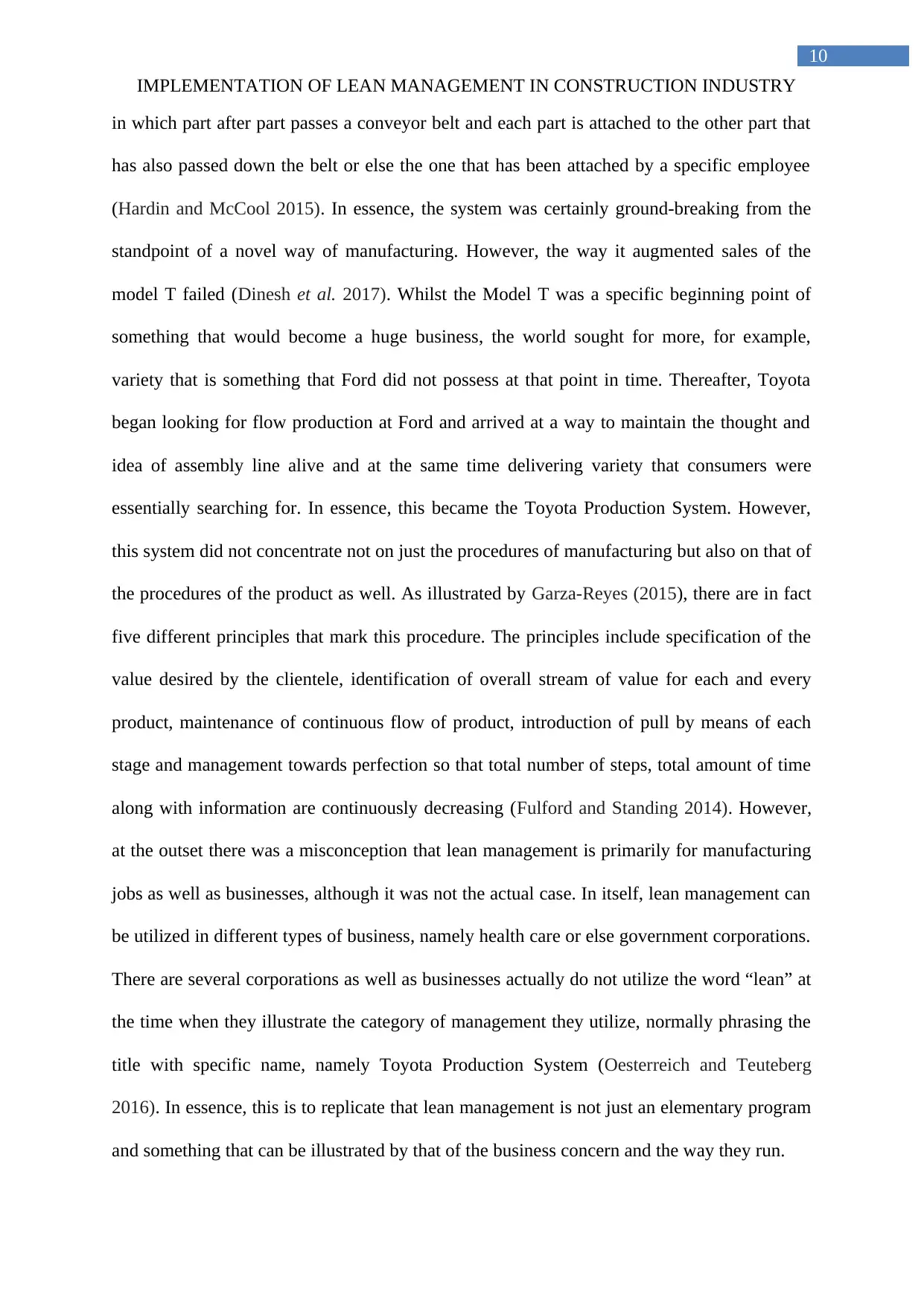
10
IMPLEMENTATION OF LEAN MANAGEMENT IN CONSTRUCTION INDUSTRY
in which part after part passes a conveyor belt and each part is attached to the other part that
has also passed down the belt or else the one that has been attached by a specific employee
(Hardin and McCool 2015). In essence, the system was certainly ground-breaking from the
standpoint of a novel way of manufacturing. However, the way it augmented sales of the
model T failed (Dinesh et al. 2017). Whilst the Model T was a specific beginning point of
something that would become a huge business, the world sought for more, for example,
variety that is something that Ford did not possess at that point in time. Thereafter, Toyota
began looking for flow production at Ford and arrived at a way to maintain the thought and
idea of assembly line alive and at the same time delivering variety that consumers were
essentially searching for. In essence, this became the Toyota Production System. However,
this system did not concentrate not on just the procedures of manufacturing but also on that of
the procedures of the product as well. As illustrated by Garza-Reyes (2015), there are in fact
five different principles that mark this procedure. The principles include specification of the
value desired by the clientele, identification of overall stream of value for each and every
product, maintenance of continuous flow of product, introduction of pull by means of each
stage and management towards perfection so that total number of steps, total amount of time
along with information are continuously decreasing (Fulford and Standing 2014). However,
at the outset there was a misconception that lean management is primarily for manufacturing
jobs as well as businesses, although it was not the actual case. In itself, lean management can
be utilized in different types of business, namely health care or else government corporations.
There are several corporations as well as businesses actually do not utilize the word “lean” at
the time when they illustrate the category of management they utilize, normally phrasing the
title with specific name, namely Toyota Production System (Oesterreich and Teuteberg
2016). In essence, this is to replicate that lean management is not just an elementary program
and something that can be illustrated by that of the business concern and the way they run.
IMPLEMENTATION OF LEAN MANAGEMENT IN CONSTRUCTION INDUSTRY
in which part after part passes a conveyor belt and each part is attached to the other part that
has also passed down the belt or else the one that has been attached by a specific employee
(Hardin and McCool 2015). In essence, the system was certainly ground-breaking from the
standpoint of a novel way of manufacturing. However, the way it augmented sales of the
model T failed (Dinesh et al. 2017). Whilst the Model T was a specific beginning point of
something that would become a huge business, the world sought for more, for example,
variety that is something that Ford did not possess at that point in time. Thereafter, Toyota
began looking for flow production at Ford and arrived at a way to maintain the thought and
idea of assembly line alive and at the same time delivering variety that consumers were
essentially searching for. In essence, this became the Toyota Production System. However,
this system did not concentrate not on just the procedures of manufacturing but also on that of
the procedures of the product as well. As illustrated by Garza-Reyes (2015), there are in fact
five different principles that mark this procedure. The principles include specification of the
value desired by the clientele, identification of overall stream of value for each and every
product, maintenance of continuous flow of product, introduction of pull by means of each
stage and management towards perfection so that total number of steps, total amount of time
along with information are continuously decreasing (Fulford and Standing 2014). However,
at the outset there was a misconception that lean management is primarily for manufacturing
jobs as well as businesses, although it was not the actual case. In itself, lean management can
be utilized in different types of business, namely health care or else government corporations.
There are several corporations as well as businesses actually do not utilize the word “lean” at
the time when they illustrate the category of management they utilize, normally phrasing the
title with specific name, namely Toyota Production System (Oesterreich and Teuteberg
2016). In essence, this is to replicate that lean management is not just an elementary program
and something that can be illustrated by that of the business concern and the way they run.
Paraphrase This Document
Need a fresh take? Get an instant paraphrase of this document with our AI Paraphraser
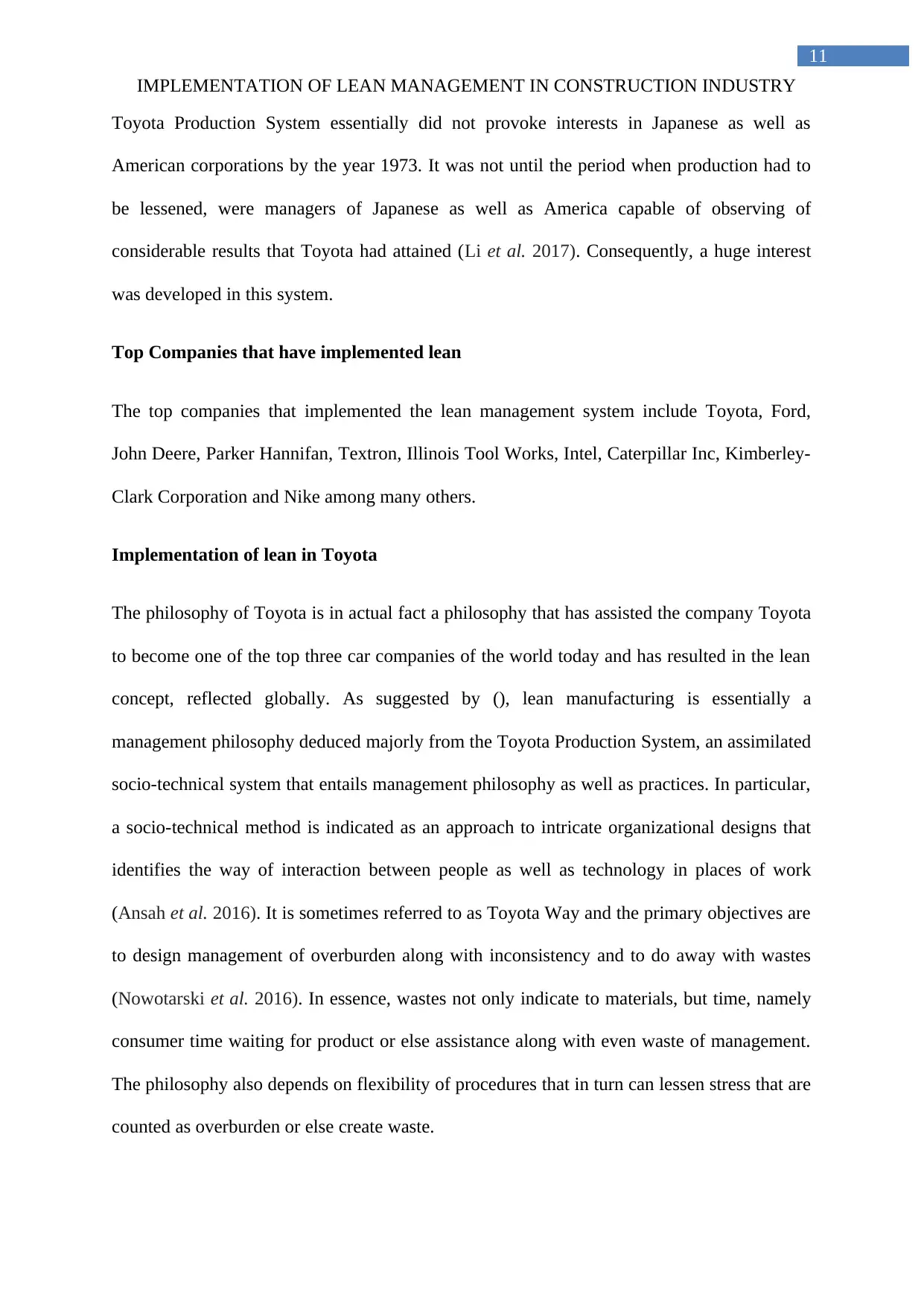
11
IMPLEMENTATION OF LEAN MANAGEMENT IN CONSTRUCTION INDUSTRY
Toyota Production System essentially did not provoke interests in Japanese as well as
American corporations by the year 1973. It was not until the period when production had to
be lessened, were managers of Japanese as well as America capable of observing of
considerable results that Toyota had attained (Li et al. 2017). Consequently, a huge interest
was developed in this system.
Top Companies that have implemented lean
The top companies that implemented the lean management system include Toyota, Ford,
John Deere, Parker Hannifan, Textron, Illinois Tool Works, Intel, Caterpillar Inc, Kimberley-
Clark Corporation and Nike among many others.
Implementation of lean in Toyota
The philosophy of Toyota is in actual fact a philosophy that has assisted the company Toyota
to become one of the top three car companies of the world today and has resulted in the lean
concept, reflected globally. As suggested by (), lean manufacturing is essentially a
management philosophy deduced majorly from the Toyota Production System, an assimilated
socio-technical system that entails management philosophy as well as practices. In particular,
a socio-technical method is indicated as an approach to intricate organizational designs that
identifies the way of interaction between people as well as technology in places of work
(Ansah et al. 2016). It is sometimes referred to as Toyota Way and the primary objectives are
to design management of overburden along with inconsistency and to do away with wastes
(Nowotarski et al. 2016). In essence, wastes not only indicate to materials, but time, namely
consumer time waiting for product or else assistance along with even waste of management.
The philosophy also depends on flexibility of procedures that in turn can lessen stress that are
counted as overburden or else create waste.
IMPLEMENTATION OF LEAN MANAGEMENT IN CONSTRUCTION INDUSTRY
Toyota Production System essentially did not provoke interests in Japanese as well as
American corporations by the year 1973. It was not until the period when production had to
be lessened, were managers of Japanese as well as America capable of observing of
considerable results that Toyota had attained (Li et al. 2017). Consequently, a huge interest
was developed in this system.
Top Companies that have implemented lean
The top companies that implemented the lean management system include Toyota, Ford,
John Deere, Parker Hannifan, Textron, Illinois Tool Works, Intel, Caterpillar Inc, Kimberley-
Clark Corporation and Nike among many others.
Implementation of lean in Toyota
The philosophy of Toyota is in actual fact a philosophy that has assisted the company Toyota
to become one of the top three car companies of the world today and has resulted in the lean
concept, reflected globally. As suggested by (), lean manufacturing is essentially a
management philosophy deduced majorly from the Toyota Production System, an assimilated
socio-technical system that entails management philosophy as well as practices. In particular,
a socio-technical method is indicated as an approach to intricate organizational designs that
identifies the way of interaction between people as well as technology in places of work
(Ansah et al. 2016). It is sometimes referred to as Toyota Way and the primary objectives are
to design management of overburden along with inconsistency and to do away with wastes
(Nowotarski et al. 2016). In essence, wastes not only indicate to materials, but time, namely
consumer time waiting for product or else assistance along with even waste of management.
The philosophy also depends on flexibility of procedures that in turn can lessen stress that are
counted as overburden or else create waste.
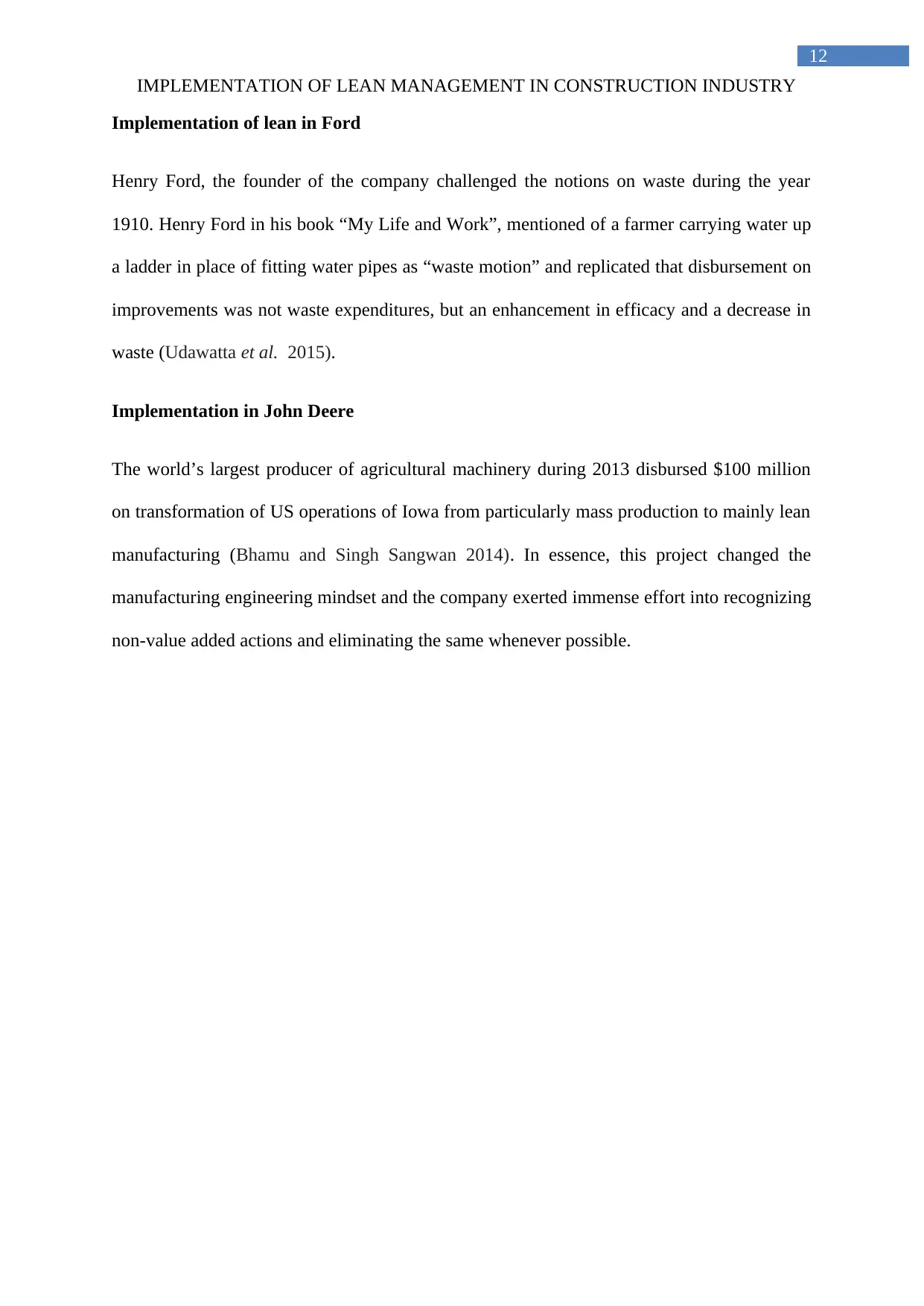
12
IMPLEMENTATION OF LEAN MANAGEMENT IN CONSTRUCTION INDUSTRY
Implementation of lean in Ford
Henry Ford, the founder of the company challenged the notions on waste during the year
1910. Henry Ford in his book “My Life and Work”, mentioned of a farmer carrying water up
a ladder in place of fitting water pipes as “waste motion” and replicated that disbursement on
improvements was not waste expenditures, but an enhancement in efficacy and a decrease in
waste (Udawatta et al. 2015).
Implementation in John Deere
The world’s largest producer of agricultural machinery during 2013 disbursed $100 million
on transformation of US operations of Iowa from particularly mass production to mainly lean
manufacturing (Bhamu and Singh Sangwan 2014). In essence, this project changed the
manufacturing engineering mindset and the company exerted immense effort into recognizing
non-value added actions and eliminating the same whenever possible.
IMPLEMENTATION OF LEAN MANAGEMENT IN CONSTRUCTION INDUSTRY
Implementation of lean in Ford
Henry Ford, the founder of the company challenged the notions on waste during the year
1910. Henry Ford in his book “My Life and Work”, mentioned of a farmer carrying water up
a ladder in place of fitting water pipes as “waste motion” and replicated that disbursement on
improvements was not waste expenditures, but an enhancement in efficacy and a decrease in
waste (Udawatta et al. 2015).
Implementation in John Deere
The world’s largest producer of agricultural machinery during 2013 disbursed $100 million
on transformation of US operations of Iowa from particularly mass production to mainly lean
manufacturing (Bhamu and Singh Sangwan 2014). In essence, this project changed the
manufacturing engineering mindset and the company exerted immense effort into recognizing
non-value added actions and eliminating the same whenever possible.
⊘ This is a preview!⊘
Do you want full access?
Subscribe today to unlock all pages.

Trusted by 1+ million students worldwide
1 out of 46
Related Documents
Your All-in-One AI-Powered Toolkit for Academic Success.
+13062052269
info@desklib.com
Available 24*7 on WhatsApp / Email
![[object Object]](/_next/static/media/star-bottom.7253800d.svg)
Unlock your academic potential
Copyright © 2020–2025 A2Z Services. All Rights Reserved. Developed and managed by ZUCOL.





